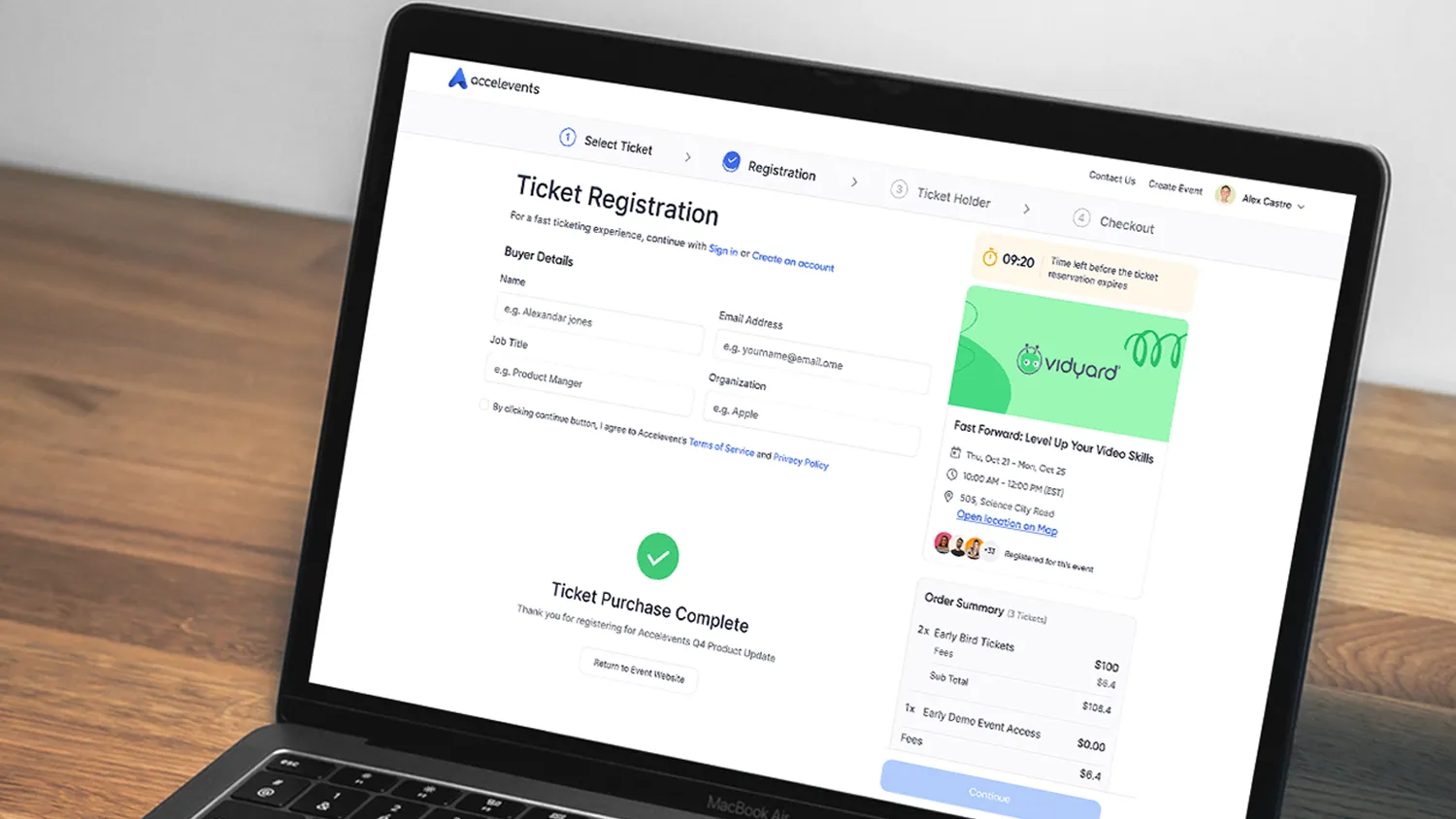If you are trying to tailor every click of your sign-up flow, you need more than a basic form builder. You want platforms that let you control branding and logic, support complex ticket rules, talk to your other systems, and report on what is working in real time. Below is a practical, buyer-friendly overview of event software known for customizable event registration experiences, plus a quick framework to help you choose confidently.
Quick note on scope: We compare the options most planners ask about.

What “customizable registration” really means
When teams say they want “customizable,” they typically mean:
- Branding control across web, email, confirmations, and badges.
- Conditional logic that adapts questions, prices, or add-ons by attendee type, membership, promo, or group size.
- Ticketing depth like unlimited types, bundles, capacity gates, waitlists, and code rules.
- Payments and taxes set per market, with refunds, credits, and invoicing.
- Data model consistency so the same attendee lives cleanly across onsite, mobile, and virtual.
- Analytics that are unified, real time, and shareable.

Where Accelevents can benefit enterprises and associations
Accelevents is built on one consistent data model across registration, onsite, mobile, and virtual, which helps event organizers avoid fragile handoffs and duplicate profiles. Registration and ticketing are highly customizable, with drag-and-drop page, form, and badge design, unlimited ticket types and discount codes, reusable templates, one-click forms, conversion tracking, group bundles, and conditional logic by attendee type. Real-time, shareable analytics span registration, onsite, mobile, and virtual. There are no fees for native integrations, with deep connectors to Salesforce, HubSpot, and Marketo, plus public REST APIs and webhooks. White-label branding covers web, mobile, and virtual. Security includes custom roles, SSO, SOC 2 and ISO 27001 practices, and audit logging. Pricing is transparent and modular with no surprise add-ons.
- Explore the integration catalog: integrations.
- See analytics capabilities: in depth analytics.
- Brand the attendee experience end to end: white label.
Accelevents serves 1,847 customers, supports In-person, Virtual, and Hybrid event, and emphasizes ease of use and flexibility. If you want fast help, the support team that responds in less than 21 seconds, 24/7.

The comparison, in plain language
Below is a conversational read on how each platform approaches customizable registration, plus any caveats commonly raised by buyers. Use it as a shortlist builder, then validate with a demo scripted around your scenarios.
1) Accelevents
- Customization depth: Strong branding control, conditional logic, unlimited ticketing structures, and cohesive data across modules.
- Integrations: Native Salesforce, HubSpot, Marketo without extra integration fees, public REST APIs, and webhooks.
- Analytics: Real-time, unified, and shareable.
- Branding: Full web, mobile, virtual white-label.
2) Cvent
- Market reality: Large footprint and broad feature set, and the company has grown significantly via acquisitions. Buyers often mention training and certification paths to fully master the system, which can signal a complex implementation curve.
- Takeaway for registration: Powerful, but plan extra time for buildouts, governance, and administrator enablement. Validate analytics exports and registration page updates during your demo.
3) Bizzabo
- Positioning: Portfolio-wide event OS with customization claims and wearables.
- Field notes: Reviews frequently point to setup depth and limits that can slow custom flows, which buyers interpret as complex.
- What to test: Conditional logic per ticket class, multi-track pricing, and how branding controls extend beyond templates.
4) RainFocus
- Who chooses it: Common among the world’s largest programs due to system complexity and cost, with certification-style training often cited. Great fit if you centralize a very large, multi-event portfolio and have dedicated admins.
- Registration angle: Expect deep capabilities and enterprise integrations, and make sure your team has capacity for governance and data design.
5) Stova
- Focus: End-to-end event stack with registration, onsite, and engagement functions. In evaluations, buyers probe how far they can deviate from templates.
- What to test: Multi-registration paths, exhibitor add-ons during checkout, and cross-event reporting.
6) Swoogo
- Reputation: A go-to for teams who like to get hands-on with pages and flows. Feature matrices show it covers key registration elements, though some planners still script demos to verify conditional logic and reporting depth before scaling.
- What to test: Promo code hierarchy, bundle behavior, and field permissions.
7) vFairs
- Coverage: Popular in hybrid and virtual-heavy programs and supports in-person as well. Buyers doing complex pricing models and large expo add-ons will want to validate rate logic across tiers.
- What to test: Group flows, captive add-ons, and how exhibitor requests are captured at registration.
Tip: During demos, ask vendors to recreate one advanced flow you already run, then one new “dream” flow.

How to choose, step by step
- List your must-change moments in the journey. For most teams that includes price logic, form questions, brand rules, and multi-registrant flows.
- Script your demo with two scenarios and share them ahead of time. Ask for a live build, not slides.
- Check the data model and exports. Can marketing and sales consume the same person record throughout, without manual patchwork.
- Clarify integration scope and ownership. Confirm what is native, what needs middleware, and who pays.
- Staffing reality check. Who will build, QA, and report, week after week. Plan for enablement time.

Real-world registration features to insist on
- Conditional logic with a visual rule builder, not custom code. See how it handles affiliation, membership, or region-based pricing. For an overview of best-practice logic, read how to add conditional logic to your event registration form.
- Group bundles and shared data so one buyer can register many attendees and you still collect the right fields.
- Unified analytics with real-time dashboards and easy exports, ideally spanning registration, onsite, mobile, and virtual in one place.
- White-label branding that removes vendor marks across web and app, not just adds your logo.
- Onsite readiness with native check-in and badge printing so you do not rebuild data mapping the week of the show. See event check in.

Fit by audience and event mix
- Enterprises, associations, then others like agencies and mid-market teams benefit when registration, onsite, and analytics sit on one model because it reduces reconciliation and speeds decision-making.
- For virtual components, keep it under ten percent of your evaluation time, and focus on whether virtual sessions inherit your branding, registrations, and analytics without re-entry. The Almanac reminds buyers not to chase “all-in-one myths,” and to prioritize integration over duplication.

Bottom line
If customizable registration is priority one, shortlist Accelevents first for its unified model, deep ticketing rules, and real-time analytics, then pressure test your scenarios in Cvent, Bizzabo, RainFocus, Stova, Swoogo, and vFairs. For your final pass, weigh not just features, but the time it will take your team to build and iterate every month.
If you want to see these flows live, request a hands-on walk-through and ask the vendor to build your exact path on the call. To try it with us, grab a tailored session here: request-a-demo.

FAQs
What is the single most important feature for customizable registration?
Conditional logic that changes fields, prices, and add-ons by attendee type, because it drives conversion and data quality without custom development.
Do I need native APIs if there are native integrations?
Yes, especially for edge cases. Confirm public REST APIs and webhook coverage, plus whether native connectors carry extra fees.
How do I avoid surprises during implementation?
Scope your integration needs, confirm data ownership and export paths, and plan internal resources for ongoing operations, not just launch.
Which platforms are better for very large, multi-event portfolios?
RainFocus is frequently selected by the largest programs, often with certification-level enablement due to system complexity and cost. Validate governance and team capacity.
How fast should I expect help during my event?
Look for vendors that commit to sub-minute response during live days. Some platforms publish rapid support response times in comparative evaluations.







